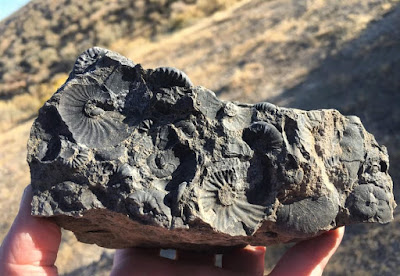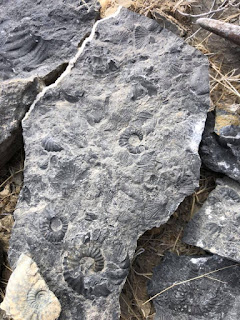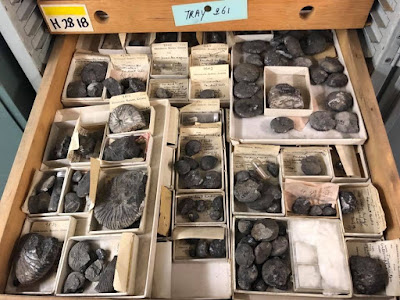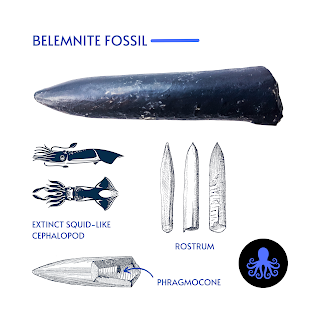 |
| Grambergia sp. Middle Triassic Ammonoid of BC, Canada |
Lower and upper Triassic faunas of these areas, as well as some that are today up to 63 ° North, have the characteristics of the lower palaeo latitudes.
A distinction between the provinces of the middle and the higher palaeo-situations can not be made for the lower Triassic and lower Middle Triassic (anise). However, all three provinces can be seen in the deposits of Ladin, Kam and Nor.
In the early 2000s, as part of a series of joint UBC, VIPS and VanPS fossil field trips (and then Chair of the VanPS), I explored much of the lower faunal outcrops of northeastern British Columbia. It was my first time seeing many of British Columbia's Triassic outcrops. Years later, and fueled by seeing paper after paper correlating the faunal assemblages of BC to those of Nevada, I had the very great pleasure of walking through the Nevada strata with John Fam (VanPS, Vice-Chair), Dan Bowen (VIPS, Chair) and Betty Franklin (VIPS, Goddess of Everything and BCPA, Treasurer) — and witnessing first-hand the correlation between the Nevada fauna and those from the Triassic of British Columbia, Canada.
 |
| Triassic ammonoids, West Humboldt Mountains, Nevada, USA |
Aside from sheer beauty and spectacular preservation, the ammonoids and belemnites were tucked in cozily with very well preserved ichthyosaur remains.
Tozer's interest in our marine invert friends was their distribution. How and when did certain species migrate, cluster, evolve — and for those that were prolific, how could their occurrence — and therefore significance — aide in an assessment of plate and terrane movements that would help us to determine paleolatitudinal significance.
 |
| Middle Triassic (Anisian/Ladinian) Fauna |
N. J. Siberling from the US Geological Survey published on these same Nevada outcrops in 1962. His work included nearly a dozen successive ammonite faunas, many of which were variants on previously described species. Both their works would inform what would become a lifelong piecing together of the Triassic puzzle for Tozer.
The terranes that now form the western Cordillera were probably welded together and reached the North American plate before the end of the Jurassic period.
Marine Triassic occurs on the North American Plate over a latitudinal spread of 46 degrees, from California to Ellesmere Island. At some intervals of time faunas on the Plate permit the discrimination of two or three provinces with distinctively different coeval faunas.
 |
| Juvavites sp. Geological Survey of Canada. Photo: John Fam |
Lower and Upper Triassic faunas from these terranes, including some which today are at 63 degrees north, have the characters of the LPL province.
Middle Triassic faunas from the terranes, as presently known, do not contribute significant data. In the terranes of the Western Cordillera, LPL faunas were now up to 3,000 km north of their counterparts on the American Plate. Through the fossil fauna assemblages, we can see this level of tectonic displacement.
Taking into account the faunas and the nature of the rocks, the Triassic paleogeography is interpreted as a tectonically quiet west shore for the North American Plate, bordered by an open sea or ocean; then, well off-shore, a series of volcanic archipelagos shedding sediment into adjacent basins. Some were fringed or intermittently covered by coralline shoals and carbonate banks. Deeper basins were in between. The islands probably were within 30 degrees of the Triassic equator and extended offshore for about 5000 km, to the spreading ridge directly ancestral to the East Pacific Rise. The geography west of the spreading ridge was probably comparable.
At the end of the Rhaetian (part of the Triassic period), most of the ammonites had died out. These are the lovely coiled molluscs you often see in museums and gift shops that sell fossils. They are a particular favourite of mine and they are both beautiful and useful to tell us much about deep time. The Hettangian, a rather poorly understood 3 million year time interval followed the Triassic-Jurassic mass extinction event.
During the Hettangian, the new or Neoammonites developed quite quickly. Within a million years, a fairly large, diverse selection of genera and species had risen to fill the void. The gap created by the Triassic-Jurassic extinction event was re-filled and our ability to "read the rocks' to understand their continued movement through tectonic plate shifting recommenced.
 |
| Alsatites proaries, Hettangian Ammonite |
This Hettangian ammonite, Alsatites proaries, is a lovely example of the cephalopods cruising our ancient oceans at that time. Alsatites is an extinct genus of cephalopod belonging to the Ammonite subclass. They lived during the Early Jurassic, Hettangian till the Sinemurian and are generally extremely evolute, many whorled with a broad keel. Or, as described by one of my very young friends, he looks like a coiled snake you make in pottery class.
The Hettangian is an interesting little period of our history. It spans the time between 201.3 ± 0.2 Ma and 199.3 ± 0.3 Ma (million years ago). For my European friends, the Hettangian is the time in which the marine limestone, shales and clay Lias of western Europe were deposited. In British Columbia, Canada, we see the most diverse middle and late Hettangian (Early Jurassic) ammonite assemblages in the Queen Charlotte Islands (Haida Gwaii), an archipelago about 50 km off British Columbia's northern Pacific coast. In total, 53 ammonite taxa are described of which Paradasyceras carteri, Franziceras kennecottense, Pleuroacanthites charlottensis, Ectocentrites pacificus and Curviceras haidae are new.
In general, North American Early Jurassic ammonites are of Tethyan affinity or endemic to the eastern Pacific. For this reason, a separate zonation for the Hettangian and Sinemurian of the Western Cordillera of North America was established. Taylor et al. (2001), wrote up and published on much of this early research though, at the time, very little Canadian information was included.
Longridge, L. M., et al. “Three New Species of the Hettangian (Early Jurassic) Ammonite Sunrisites from British Columbia, Canada.” Journal of Paleontology, vol. 82, no. 1, 2008, pp. 128–139. JSTOR, www.jstor.org/stable/20144175. Accessed 27 Jan. 2020.
Tozer, ET (Tim): Marine Triassic faunas of North America: Their significance for assessing plate and terrane movements. Geol Rundsch 71, 1077-1104 (1982). https://doi.org/10.1007/BF01821119
Danner, W. (Ted): Limestone resources of southwestern British Columbia. Montana Bur. Mines & Geol., Special publ. 74: 171-185, 1976.
Davis, G., Monger, JWH & Burchfiel, BC: Mesozoic construction of the Cordilleran “collage”, central British Columbia to central California. Pacific Coast Paleography symposium 2, Soc. Economic Paleontologists and Mineralogists, Los Angeles: 1-32, 1978.
Gibson, DW: Triassic rocks of the Rocky Mountain foothills and front ranges of northeastern British Columbia and west-central Alberta. Geol. Surv. Canada Bull. 247, 1975.
Photo of the large belemnite (Atractites sp?) and ammonites (Sunrisites & Badouxia) from the Lower Jurassic (Late Hettangian), Last Creek Formation (Castle Pass member), Taseko Lakes area, British Columbia, Canada in the collection of the deeply awesome John Fam.
Photo: A drawer of Juvavites sp. in the collections of the Geological Survey of Canada. These rarely seen Upper Triassic (Carnian to Norian) ammonoids were collected over many decades by geologists of the Geological Survey of Canada from Northeastern British Columbia. Photo care of the deeply awesome John Fam.
Photo: Grambergia sp. from the Early Anisian (Middle Triassic) ammonoid biostratigraphy of northeastern British Columbia, Canada. Collection of Fossil Huntress.
Photo: Alsatites proaries, Coll. Reiter, Neoammoniten, 30 July 2011, 19:26:10




















.png)




